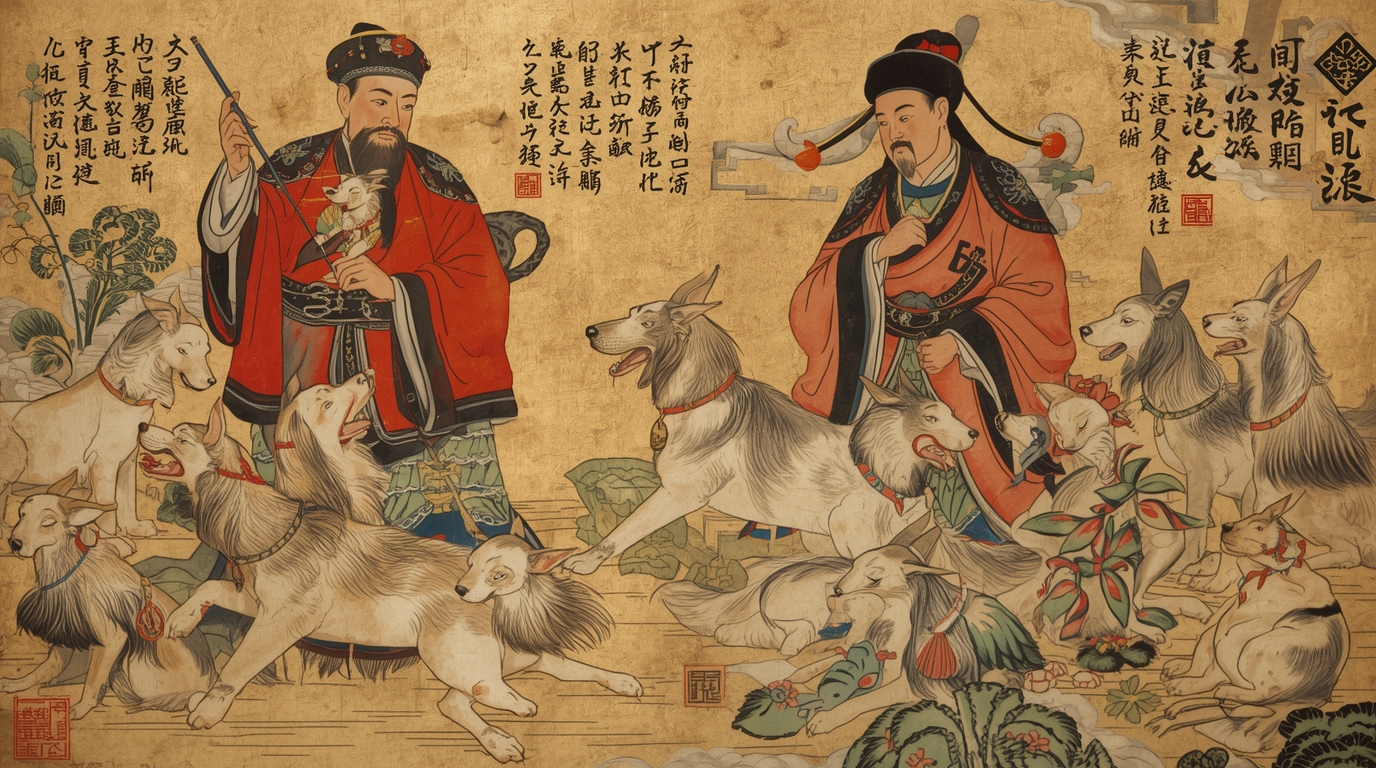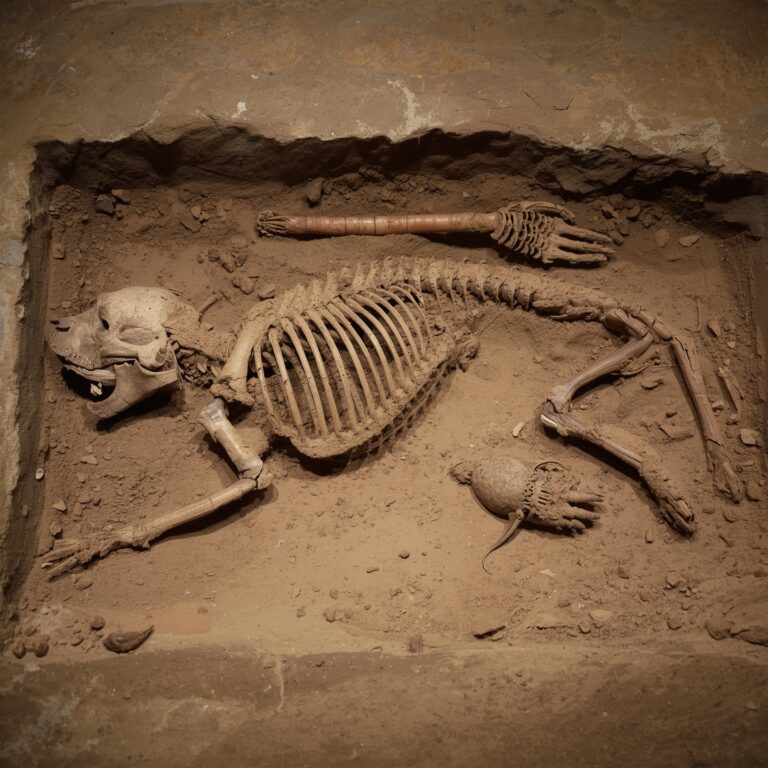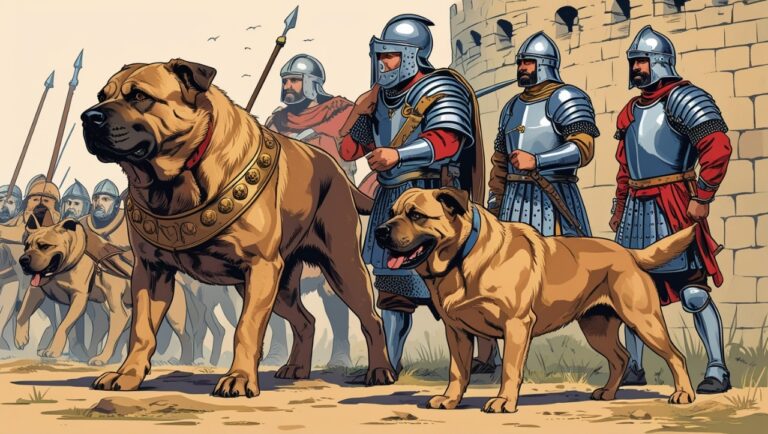Dogs in Ancient China and the Tang Dynasty

Introduction: Canines in the Ancient Chinese World
Dogs have occupied a special place in Chinese civilization for over 7,000 years. In Ancient China, and especially during the Tang Dynasty (618–907 CE), dogs were revered not just as pets but as symbols of loyalty, protection, and even divine energy. Their presence spanned palaces, temples, marketplaces, and battlefields—carrying meanings that were practical, symbolic, spiritual, and aesthetic.
Origins of Dog Domestication in China
Archaeological digs in Neolithic settlements like Banpo reveal domesticated dog skeletons, some dating as far back as 5000 BCE. Dogs were initially used for hunting and guarding, but by the Shang Dynasty, their roles expanded to include spiritual and ritualistic functions.
Dogs in Early Chinese Dynasties Before Tang
During the Zhou Dynasty, dogs were often buried with their owners as guides to the afterlife. In the Han Dynasty, miniature ceramic dogs were buried in tombs, symbolizing protection. Texts like the Rites of Zhou mention dogs as part of court and military structures, indicating their increasing societal value.
The Tang Dynasty: A Golden Era for Dogs
The Tang Dynasty ushered in a period of openness, artistry, and refined court life. Dogs became prominent as companions of the elite, particularly within imperial palaces. Under Empress Wu Zetian, dogs were treated with reverence. She was known to keep small breeds by her side, representing both status and emotional companionship.
Chinese Dog Breeds During the Tang Dynasty
The Pekingese originated from palace breeding programs. Legend says these dogs were born from the love of a lion and a marmoset, symbolizing courage in a small body. They were exclusive to royalty and were punished by death if stolen.
The Shih Tzu and Lhasa Apso, though more Tibetan in origin, were heavily exchanged during Tang trade routes. These dogs were known for their flowing coats and stoic postures.
The Chow Chow, recognizable by its blue-black tongue and lion-like mane, began to appear in Tang imagery, often used as both guard and pet.
Dogs in Tang Dynasty Art and Literature
Tang artists depicted dogs in scrolls and pottery. Porcelain dog figurines, sometimes painted in cobalt blue, were popular grave goods. Tang poets, such as Bai Juyi, referenced dogs in pastoral verses, likening their loyalty to that of servants or soldiers.
Dogs appeared in court paintings alongside nobility, emphasizing their elevated status. Their presence in art underlined cultural reverence for their form, function, and symbolism.
Religious Roles of Dogs in Chinese Temples
Dogs held guardian status in Buddhist and Taoist temples. Many temples had live dogs or dog statues to ward off demons and misfortune. In Chan Buddhism, dogs were seen as creatures capable of reincarnation and deserving of compassion.
In Taoism, dogs symbolized protection from evil spirits and were often invoked during spiritual rituals, especially in countryside shrines.
Foo Dogs (Shi or Guardian Lions) and Mythical Representation
Commonly called “Foo Dogs,” these are not actual dogs but stylized guardian lions. Despite their feline origin, they inherited the dog’s spiritual roles—loyalty, vigilance, and sacred protection. Found in front of temples and palaces, they came in male-female pairs symbolizing yin and yang.
Their appearance during the Tang period became more elaborate, often carved from marble or cast in bronze, showing the influence of Buddhist sculpture aesthetics.
Symbolism of Dogs in Chinese Culture
In Chinese cosmology, dogs symbolize fidelity, honesty, and protectiveness. As the 11th animal of the zodiac, people born in the year of the Dog are said to be loyal, brave, and dependable.
During the Tang period, gifting a dog to someone was a sign of trust and loyalty. Their bark was believed to scare away ghosts and invite prosperity.
Dogs and Confucianism: Family and Filial Piety
Confucian values emphasize hierarchy, loyalty, and filial piety—traits often ascribed to dogs. Stories from the Tang period highlight dogs alerting families to fires or defending children from wild animals, exemplifying their alignment with moral ideals.
Although Confucian thought viewed animals as subordinates, dogs occupied a special place for their unquestioning loyalty.
The Social Status of Dog Ownership
Dog ownership during the Tang Dynasty reflected class divisions. Royalty and nobles kept exotic breeds adorned with embroidered cushions and golden collars. Peasants, meanwhile, kept dogs for utility—herding livestock, guarding homes, or scavenging.
Illustrations from the Tang period often show dogs walking beside ladies of the court, signaling their integration into domestic aristocratic life.
Dog Breeding and Imperial Kennels
The Tang court maintained imperial kennels staffed with attendants responsible for grooming, training, and feeding dogs. Breeds were chosen based on specific attributes—size, agility, temperament, or appearance.
Historical records mention breeding programs in cities like Luoyang and Chang’an, where dogs were treated as royal assets and often gifted to foreign dignitaries as diplomatic presents.
Dogs in Daily Life: Pets, Guards, and Workers
Common families relied on dogs for practical roles—guarding gates, protecting food stores, and herding. Street dogs also played roles as informal sentries in markets.
Despite their lower-class associations in some regions, many urban households developed emotional bonds with dogs, naming them and including them in family rituals and stories.
Funeral Practices and Dog Burials
Buried dogs from the Tang Dynasty have been found with collars, amulets, and miniature pottery replicas. Tombs in Xi’an and Luoyang reveal that dogs were often laid beside their owners with inscriptions expressing grief and respect.
Some dog tombs contained ceramic pillows and written charms to ensure their comfort in the afterlife, emphasizing belief in canine souls and continuity.
Protective Amulets and Dog-Themed Charms
People in the Tang Dynasty wore dog-shaped pendants carved from jade or bone to ward off spirits and bring luck. Soldiers sometimes carried bronze amulets depicting barking dogs for battlefield protection.
Children’s clothes were often embroidered with dog patterns, believed to repel evil spirits and attract positive energy.
Dogs in Chinese Folklore and Oral Traditions
Folk tales from the Tang era include stories of magical dogs who transform into humans, save villages from bandits, or serve emperors in disguise. One famous story tells of a white dog who led a blind monk through mountain passes, earning divine reward.
Such tales reinforced the mystical role of dogs as messengers between worlds or agents of fate.
Dog-Related Laws and Etiquettes
Tang legal codes referenced animal welfare, particularly the fair treatment of domestic animals. Theft of imperial dogs was punishable by severe penalties, while mistreatment of a family dog could be grounds for community shame.
Etiquette guides from the era also dictated how dogs should be groomed, spoken to, and included in household routines.
Gender and Dog Companionship
Court women during the Tang Dynasty were often depicted with lapdogs. These dogs were considered emblems of femininity, grace, and delicacy. Women expressed affection through poetic verses dedicated to their pets, often likening them to protective siblings or cherished lovers.
Lapdogs were allowed in women’s quarters, providing emotional comfort and companionship in highly structured domestic spaces.
Legacy of Tang Dynasty Dog Culture in Modern China
Many modern Chinese dog breeds such as the Pekingese, Shih Tzu, and Chow Chow carry the cultural DNA of Tang Dynasty preferences. Museums and historical parks continue to display dog statues from the era, while contemporary artists revive Tang styles to portray canine subjects.
In literature, dogs are still painted as symbols of loyalty and cosmic order, echoing themes from this golden age.
Conclusion: The Enduring Bond Between Dogs and Chinese Civilization
From temples to palaces, battlefields to homes, dogs in Ancient China and the Tang Dynasty served as faithful companions, sacred guardians, and cultural icons. Their roles reflected deeper truths about Chinese values—loyalty, hierarchy, spirituality, and aesthetic harmony. Today, these ancient bonds continue to shape how modern China reveres and represents its canine companions.





